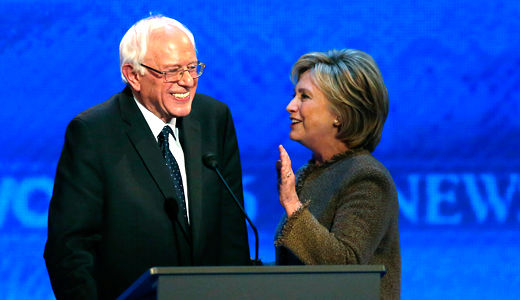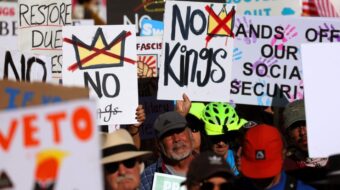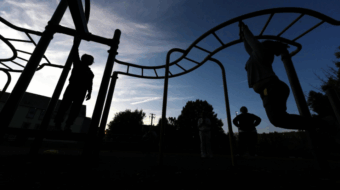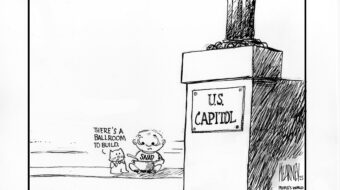
It is finally here. The thing politicos and newswatchers have been looking forward to with either anticipation or dread for nigh on a year: presidential primary season.
All the debates, rallies, and fundraisers held so far have been preparing the ground for February 2016, when the first actual ballots of this year’s election will be cast. This is where the rubber will hit the road and we start to find out how much support the various presidential candidates have among voters. First up will be Iowa and New Hampshire, followed by Nevada and South Carolina, then onward to the big prize of Super Tuesday in March, and then the rest of the states strung out all the way to June.
While of course the vote in November remains the key focus point for stopping the GOP, progressive activists should not underestimate the importance of the primaries. For anyone interested in pushing American politics and economics to the left, this is actually the period where the major parties are most open to change and pressure. Primary season is when the need for nuance in the anti-ultra right electoral strategy becomes apparent.
The primary process for selecting presidential candidates is anything but straightforward, though. For anyone not up on the ins and outs of party intrigue or the history of factional bickering within the Democratic National Committee over the past half century, the mishmash of caucuses, primaries, nominations, delegates, and superdelegates can all seem a bit confusing. Knowing a bit about the background of all these terms and processes can help activists to orient themselves in this most American of political events.
The small-d democratic essence of the primary system
Though presidential primaries have existed in one form or another for a century, the real history of the presidential nomination system that we all know today dates from 1968 and the battles in the streets of Chicago outside the Democratic National Convention that year.
From the end of World War II up through the mid-1960s, the Democratic Party was controlled by what has come to be called the “Liberal-Labor faction,” which consisted of urban Democratic politicians and the top leadership of the major trade unions. This was a time when the labor movement was dominated by anticommunist and pro-Vietnam War leaders such as George Meany, who headed up the AFL-CIO. The bond between conservative union leaders and Democratic Party officials was an important characteristic of the candidate nomination process during this period.
According to the pre-1968 rules, state party leaders possessed the authority to choose the majority of the delegates to the national party convention. Given their power in the state party organizations, this also guaranteed the influence of the conservative trade union leadership.
Ignoring the wishes of much of the party’s base, the top Democratic bureaucrats and the trade union officialdom handed the 1968 nomination to Hubert Humphrey. The activists of the civil rights, women’s equality, youth, and peace movements – along with important grassroots sections of labor – stood opposed to the undemocratic way that the nomination was given to Humphrey. They had not forgotten the fact that Humphrey (along with UAW leader Walter Reuther) had played a key role in blocking the efforts of Fannie Lou Hamer’s anti-segregationist Mississippi Freedom Democratic Party to unseat their state’s all-white delegation at the convention four years earlier.
The delegates who had supported anti-war candidates such as Eugene McCarthy and the recently assassinated Robert F. Kennedy came together with the protestors facing off against Chicago Mayor Richard Daley’s police force on the streets outside the hall to force a change in the Democratic nomination process.
In a combination of anger and action, activists pushed to reform the rules for delegate selection and ended up giving birth to the modern presidential primary system. George McGovern chaired a reform commission that took up most of the grassroots’ demands. The practice of allowing state party leaders to handpick delegates was ended and replaced by an open selection process and a quota system that ensured proportionate representation by gender, race, and age. The rule that required all state delegates to vote as a bloc was also dropped.
To comply with the new rules, many state legislatures instituted primary elections to select convention delegates rather than state party conventions. Some states, like Iowa, retained the caucus system run by the parties themselves, which is different than the primary election but functions along similar lines. And since election laws for primaries usually apply equally to both parties, the Republican Party was also forced to switch to a primary system for candidate selection.
The transformation of the Democratic Party was obvious by the following national convention. In 1972, the Illinois delegation led by Mayor Daley was refused credentials because it failed to include adequate representation of women and African Americans. An alternative delegation led by Jesse Jackson took their place. The party nominated anti-war candidate George McGovern for president.
The platform that year called for the immediate withdrawal of U.S. forces from Southeast Asia, cuts to military spending, improved relations with the Soviet Union, stronger gun control legislation, amnesty for conscientious objectors, improved school integration, the abolition of the Electoral College, a guaranteed income for all Americans, and an Equal Rights Amendment to the Constitution. Power shifted from the party bureaucracy to the reform activists of the equality and peace movements.
Make no mistake about it – the primary nomination system was a victory for democracy. It opened the Democratic Party to pressure from the mass movements and forced presidential candidates to engage with social movements and activist organizations in a way that they never had before.
Superdelegates and Super Tuesday
So what happened next?
As is always the case, every step forward provokes a reaction. The democratization of the presidential nomination system was no different. By the mid-1980s, centrist Democrats – especially conservative white party leaders from the South – were saying the reforms had allowed activists to nominate candidates who were too far to the left. They argued being too democratic was keeping the party from winning. They set their sights on reversing the 1968 rules that had opened up the delegate selection process.
Calling themselves the Committee for Party Effectiveness (CPE), they sought to take power back from the people’s movements operating in the Democratic Party and return it to Congressmen and elected officials.
One of their first moves was to water down the power of the delegates elected by voters in the open primary elections. In 1984, the CPE managed to push through the DNC its own ‘reform’ to add on extra delegates to each state’s delegation. These ‘add-on’ seats were not democratically elected through the primaries, but rather they were reserved for party leaders and politicians already holding office. They were used to provide a guaranteed spot at the convention for state party chairpersons, governors, big city mayors, as well as most of the House and Senate members.
These extra, unelected delegates were soon called “superdelegates.” They got this designation because, unlike the delegates selected by the primaries who were apportioned to presidential candidates based on the votes received, these superdelegates were free to support any candidate they chose at the convention. This meant that the party establishment could now put a stumbling block in the path of any insurgent left candidate.
There were still not enough superdelegates to deny a populist candidate the nomination though if he or she was able to garner enough grassroots support. The success of the Jesse Jackson campaign in uniting a broad multiracial, progressive, working class-based coalition in 1984 proved to the big business-linked conservative Democrats, now calling themselves the Democratic Leadership Council and backed by K Street corporate lobbyists, that they needed to do more.
The “Super Tuesday” regional primary became their next focus. Although the phrase had been around since at least the 1970s to describe days when multiple states held primaries, in 1988 Super Tuesday became a weapon aimed at blocking left wing candidates. In that year, Southern Democrats moved the primaries of Alabama, Florida, Georgia, Kentucky, Louisiana, Mississippi, Oklahoma, Tennessee, and Texas all onto the same day. This Southern Super Tuesday was envisioned as a solid wall of conservative (mostly white) voters to stop any progressive tide.
The strategy backfired, however, as African-American voters in the South came out in strong numbers for Jackson and gave him victories in five states. There were so many other candidates that year, however, that the rest of the states were divided among them. Jackson didn’t have enough to prevail. Too many other states had also moved their primaries to Super Tuesday that it was hard for Democrats to tailor their message exclusively to Southern white conservatives.
In later elections though, Super Tuesday performed just as planned. Bill Clinton, Bob Dole, George W. Bush, and Al Gore were all beneficiaries of Super Tuesday victories. By 2008, 24 states had moved their primaries to Super Tuesday, awarding over half of convention delegates on this one day. With two strong candidates like Barack Obama and Hillary Clinton, it was a split day in ’08. But for insurgent candidates like Bernie Sanders, it may well be a make or break day in 2016.
Why this all matters for progressives
The presidential nomination system we are left with today is a product of both democratic victories by the people’s movements and reactionary reversals from big business-linked party operatives. It is a complex machine that presents a lot of opportunities but also a lot of hurdles.
When engaging in electoral struggle, many on the left focus much of their attention on the all-important general election. This is the day in November when it is all hands on deck to bring as many voters to the polls as possible. In the months leading up to it, we are all registering voters, knocking on doors, making phone calls, attending rallies, distributing signs, buttons, and pamphlets. We talk to our neighbors, our co-workers, our friends, our family, and our connections in various movements and organizations about the issues at stake and the importance of beating the ultra-right.
While all of that should remain at the top of our agenda when it comes to electoral struggle, the primaries and the lead up to them deserve just as much attention and work. The primaries are the time when the major parties are most malleable. This is when campaign priorities are set and decisions are made about which candidate’s delegates will be writing the playbook for November.
Often it is said that progressives have to hold their nose and vote for whatever candidate can beat the Republican. If the left, progressive, and working class forces assert themselves and apply pressure during the primaries, they will have a stronger role in determining what option is put forward on the Democratic side in November. A strong contingent of working class and progressive delegates at the DNC this summer can have a major impact on the shape of the Democratic platform. Their influence can be felt no matter who the nominee is. The extent of that influence depends largely on what we do right now.
The strong endorsements given to Sanders by the Communications Workers of America, National Nurses United, the American Postal Workers Union, and several locals are examples of how labor is taking a lead in shaping the primaries. Democracy for America, Progressive Democrats of America, and the Working Families Party are doing likewise in backing Sanders. The unions endorsing Clinton, like AFSCME, NEA, AFT, and SEIU, are also moving early to make their mark on the campaign.
We have to look beyond endorsements though. The phone banking, door knocking, and talking to everyone we know about the issues and candidates should already be underway. Start getting people registered to vote. Getting involved now will mean less nose-holding later.
Primary Season Calendar
February 1 – Iowa
February 9 – New Hampshire
February 20 – Nevada
February 27 – South Carolina
March 1 – Super Tuesday – Alabama, Arkansas, Colorado, Georgia, Massachusetts, Minnesota, Oklahoma, Tennessee, Texas, Vermont, Virginia
March 5 – Kansas, Louisiana, Nebraska
March 6 – Maine
March 8 – Mississippi, Michigan
March 15 – Florida, Illinois, Missouri, North Carolina, Ohio
March 22 – Arizona, Utah
March 26 – Alaska, Hawaii, Washington
April 5 – Wisconsin
April 9 — Wyoming
April 19 – New York
April 26 – Connecticut, Delaware, Maryland, Pennsylvania, Rhode Island
May 3 – Indiana
May 10 – West Virginia
May 17 – Kentucky, Oregon
June 5 – Puerto Rico
June 7 – California, Montana, New Jersey, New Mexico, North Dakota, South Dakota
June 14 – Washington D.C.
Photo: Hillary Clinton speaks to Bernie Sanders during a break at the Democratic presidential primary debate, Dec. 19, 2015, at Saint Anselm College in Manchester, N.H. Jim Cole | AP










